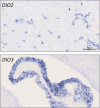Deiodinases: How Nonmammalian Research Helped Shape Our Present View
- PMID: 33606002
- PMCID: PMC8143656
- DOI: 10.1210/endocr/bqab039
Deiodinases: How Nonmammalian Research Helped Shape Our Present View
Abstract
Iodothyronine deiodinases are enzymes capable of activating and inactivating thyroid hormones (THs) and have an important role in regulating TH action in tissues throughout the body. Three types of deiodinases (D1, D2, and D3) were originally defined based on their biochemical characteristics. Cloning of the first complementary DNAs in the 1990s (Dio1 in rat and dio2 and dio3 in frog) allowed to confirm the existence of 3 distinct enzymes. Over the years, increasing genomic information revealed that deiodinases are present in all chordates, vertebrates, and nonvertebrates and that they can even be found in some mollusks and annelids, pointing to an ancient origin. Research in nonmammalian models has substantially broadened our understanding of deiodinases. In relation to their structure, we discovered for instance that biochemical properties such as inhibition by 6-propyl-2-thiouracil, stimulation by dithiothreitol, and temperature optimum are subject to variation. Data from fish, amphibians, and birds were key in shifting our view on the relative importance of activating and inactivating deiodination pathways and in showing the impact of D2 and D3 not only in local but also whole body T3 availability. They also led to the discovery of new local functions such as the acute reciprocal changes in D2 and D3 in hypothalamic tanycytes upon photostimulation, involved in seasonal rhythmicity. With the present possibilities for rapid and precise gene silencing in any species of interest, comparative research will certainly further contribute to a better understanding of the importance of deiodinases for adequate TH action, also in humans.
Keywords: deiodinase; development; evolution; function; vertebrates.
© The Author(s) 2021. Published by Oxford University Press on behalf of the Endocrine Society.
Figures




References
-
- Bianco AC, Salvatore D, Gereben B, Berry MJ, Larsen PR. Biochemistry, cellular and molecular biology, and physiological roles of the iodothyronine selenodeiodinases. Endocr Rev. 2002;23(1):38-89. - PubMed
-
- Darras VM, Van Herck SL. Iodothyronine deiodinase structure and function: from ascidians to humans. J Endocrinol. 2012;215(2):189-206. - PubMed
-
- Leonard JL, Visser TJ. Biochemistry of deiodination. In: Hennemann G. ed. Thyroid Hormone Metabolism. Marcel Dekker; 1986:189-229.
-
- MacLatchy DL, Eales JG. Properties of T4 5’-deiodinating systems in various tissues of the rainbow trout, Oncorhynchus mykiss. Gen Comp Endocrinol. 1992;86(2):313-322. - PubMed
Publication types
MeSH terms
Substances
LinkOut - more resources
Full Text Sources
Other Literature Sources

